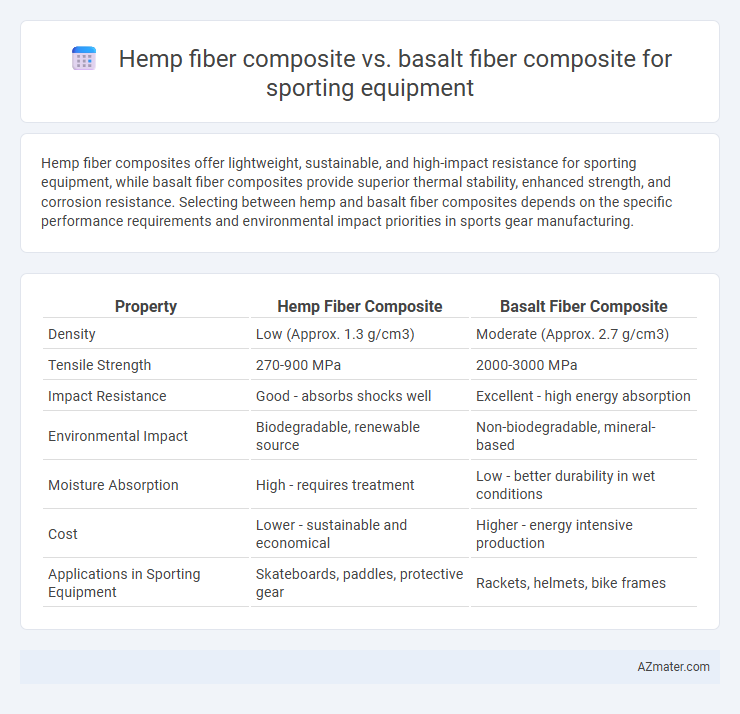Hemp fiber composites offer lightweight, sustainable, and high-impact resistance for sporting equipment, while basalt fiber composites provide superior thermal stability, enhanced strength, and corrosion resistance. Selecting between hemp and basalt fiber composites depends on the specific performance requirements and environmental impact priorities in sports gear manufacturing.
Table of Comparison
| Property | Hemp Fiber Composite | Basalt Fiber Composite |
|---|---|---|
| Density | Low (Approx. 1.3 g/cm3) | Moderate (Approx. 2.7 g/cm3) |
| Tensile Strength | 270-900 MPa | 2000-3000 MPa |
| Impact Resistance | Good - absorbs shocks well | Excellent - high energy absorption |
| Environmental Impact | Biodegradable, renewable source | Non-biodegradable, mineral-based |
| Moisture Absorption | High - requires treatment | Low - better durability in wet conditions |
| Cost | Lower - sustainable and economical | Higher - energy intensive production |
| Applications in Sporting Equipment | Skateboards, paddles, protective gear | Rackets, helmets, bike frames |
Introduction to Sustainable Fiber Composites in Sporting Equipment
Hemp fiber composites offer a renewable and biodegradable alternative with excellent impact resistance and lightweight properties for sporting equipment, promoting sustainability and reduced environmental footprint. Basalt fiber composites provide superior mechanical strength, thermal stability, and corrosion resistance, making them ideal for high-performance sports gear demanding durability and longevity. Both materials present eco-friendly options by reducing reliance on synthetic fibers and enhancing the sustainability of athletic products through innovative composite technology.
Overview of Hemp Fiber Composite Materials
Hemp fiber composite materials consist of natural hemp fibers embedded in a polymer matrix, offering remarkable strength-to-weight ratios and excellent impact resistance for sporting equipment. These composites are sustainably sourced, biodegradable, and provide enhanced vibration damping, making them an eco-friendly alternative to synthetic fibers. Their mechanical properties, such as tensile strength ranging from 400 to 600 MPa and low density around 1.3 g/cm3, contribute to lightweight and durable sports gear applications.
Overview of Basalt Fiber Composite Materials
Basalt fiber composite materials are derived from natural volcanic basalt rock, offering exceptional tensile strength, thermal stability, and resistance to chemical corrosion, making them highly suitable for sporting equipment. These composites demonstrate superior durability and lightweight properties, enhancing performance and longevity in products such as tennis rackets, bike frames, and protective gear. Compared to hemp fiber composites, basalt fibers provide improved stiffness and impact resistance, which are critical for high-performance athletic applications.
Mechanical Properties: Hemp vs Basalt Fiber Composites
Basalt fiber composites exhibit significantly higher tensile strength and modulus compared to hemp fiber composites, making them more suitable for high-performance sporting equipment requiring exceptional durability and stiffness. Hemp fiber composites offer superior impact resistance and better vibration damping due to their natural fiber structure, enhancing user comfort in sports gear. Both materials provide lightweight solutions, but basalt fibers ensure enhanced mechanical properties ideal for performance-critical applications.
Weight and Performance Efficiency Comparison
Hemp fiber composites offer lightweight properties with excellent vibration damping, making them suitable for sporting equipment that requires comfort and shock absorption. Basalt fiber composites provide higher tensile strength and thermal resistance, resulting in enhanced performance efficiency and durability under stress. Weight-wise, hemp composites are lighter but less stiff, while basalt composites balance moderate weight with superior mechanical performance for high-impact sports applications.
Environmental Impact and Sustainability Analysis
Hemp fiber composites significantly reduce carbon footprint through rapid biomass growth and low-energy processing compared to basalt fiber composites, which involve energy-intensive mining and melting of volcanic rock. Hemp fibers are biodegradable and renewable, promoting circular economy principles, while basalt fibers, though durable and recyclable, present challenges in end-of-life disposal due to their inert mineral nature. Sustainable sporting equipment designs increasingly favor hemp composites for their eco-friendly lifecycle and reduced environmental impact without compromising performance.
Cost-Effectiveness in Production and Application
Hemp fiber composites offer a significant cost advantage in sporting equipment production due to the low raw material and processing expenses, making them ideal for budget-conscious manufacturers. Basalt fiber composites, while generally more expensive, provide superior mechanical properties and durability that can justify the higher upfront cost in high-performance sports applications. Evaluating cost-effectiveness requires balancing hemp's affordability and sustainability against basalt's strength and longevity benefits in specific sporting scenarios.
Durability and Longevity in Athletic Use
Hemp fiber composites offer excellent tensile strength and natural impact resistance, making them suitable for sustainable sporting equipment with moderate durability. Basalt fiber composites exhibit superior durability and longevity due to their high thermal stability, corrosion resistance, and ability to withstand repeated mechanical stress in athletic applications. The enhanced fatigue resistance of basalt fiber composites results in longer-lasting performance under rigorous sports conditions compared to hemp fiber alternatives.
Market Trends and Adoption in Sports Industry
Hemp fiber composites are gaining traction in the sporting goods industry due to their sustainability, lightweight properties, and cost-effectiveness, appealing to eco-conscious consumers and brands focusing on green innovation. Basalt fiber composites offer superior strength, durability, and thermal resistance, making them ideal for high-performance equipment such as bicycles and protective gear, driving adoption among professional athletes and premium manufacturers. Market trends indicate a growing preference for sustainable materials like hemp and basalt fibers, with an increasing number of sports companies investing in research and development to enhance composite performance and reduce environmental impact.
Future Prospects: Innovations and Research Directions
Hemp fiber composites exhibit promising future prospects in sporting equipment due to their sustainability, biodegradability, and low environmental impact, with research focusing on enhancing fiber-matrix adhesion and improving mechanical performance through hybridization with synthetic fibers. Basalt fiber composites offer superior strength, thermal stability, and corrosion resistance, making them suitable for high-performance sports applications, with ongoing innovations targeting cost reduction and surface treatment techniques to optimize composite durability. Emerging research explores the integration of nanomaterials and bio-based resins with both hemp and basalt fibers to develop lightweight, eco-friendly sporting equipment that meets evolving industry standards.

Infographic: Hemp fiber composite vs Basalt fiber composite for Sporting equipment
 azmater.com
azmater.com